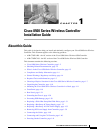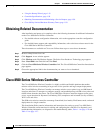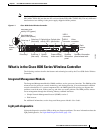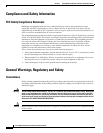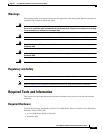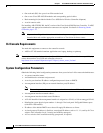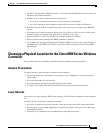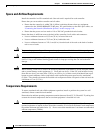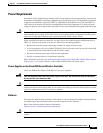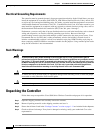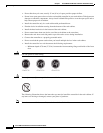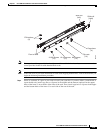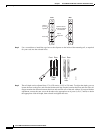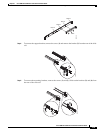
1-8
Cisco 8500 Series Wireless Controller Installation Guide
Chapter 1 Cisco 8500 Series Wireless Controller Installation Guide
Choosing a Physical Location for the Cisco 8500 Series Wireless Controller
Space and Airflow Requirements
Install the controller in a EIA-standard rack. One rack unit is required for each controller.
Ensure that you can reach the controller and all cables.
• Ensure that the controller is within 328 ft (100 m) equivalent distance from any equipment
connected to the 10/100/1000BASE-T/10G ports. For specifications on the fiber optic cables, see
“Connecting the Network (Distribution System)” section on page 1-49.
• Ensure that the power cord can reach a 110 or 220 VAC grounded electrical outlet.
Ensure that there is sufficient room at the back of the controller for all cables and connectors.
• Leave a minimum clearance of 63.5 cm (25 in.) in front of the rack.
• Leave a minimum clearance of 76.2 cm (30 in.) behind the rack.
• Leave a minimum clearance of 121.9 cm (48 in.) from the back of the rack to the back of another
rack or row of racks.
Caution To prevent improper cooling and damage to the equipment, do not block the ventilation openings.
Caution Always use blanking panels to fill empty vertical spaces in the rack. This arrangement ensures proper
airflow. Using a rack without blanking panels results in improper cooling that can lead to thermal
damage.
Caution When selecting a rack to use, observe the following additional requirements to ensure adequate airflow
and to prevent damage to the equipment: (1) Front and rear doors—If the 42U rack includes closing
front and rear doors, you must allow 5,350 sq. cm (830 sq. in.) of holes evenly distributed from top to
bottom to permit adequate airflow (equivalent to the required 64 percent open area for ventilation).
(2)
Side—The clearance between the installed rack component and the side panels of the rack must be
a minimum of 7 cm (2.75 in.).
Temperature Requirements
To ensure continued safe and reliable equipment operation, install or position the system in a well
ventilated, climate-controlled environment.
Ensure that the ambient operating temperature remains between 10 and 35° C (50 and 95° F), taking into
account the elevated temperatures that occur when equipment is installed in a rack.
Caution To reduce the risk of damage to the equipment when installing third-party options: (1) Do not permit
optional equipment to impede airflow around the controller or to increase the internal rack temperature
beyond the maximum allowable limits. (2) Do not exceed the manufacturer’s maximum recommended
ambient temperature (TMRA).




